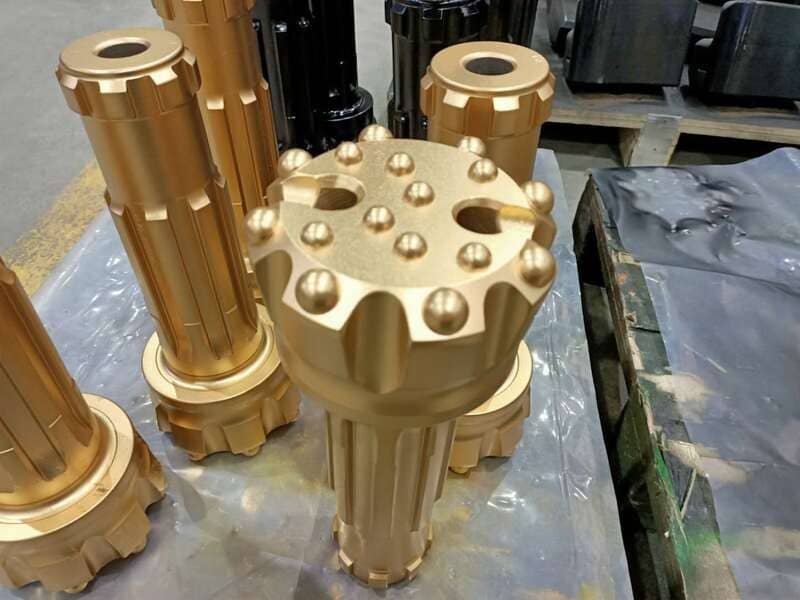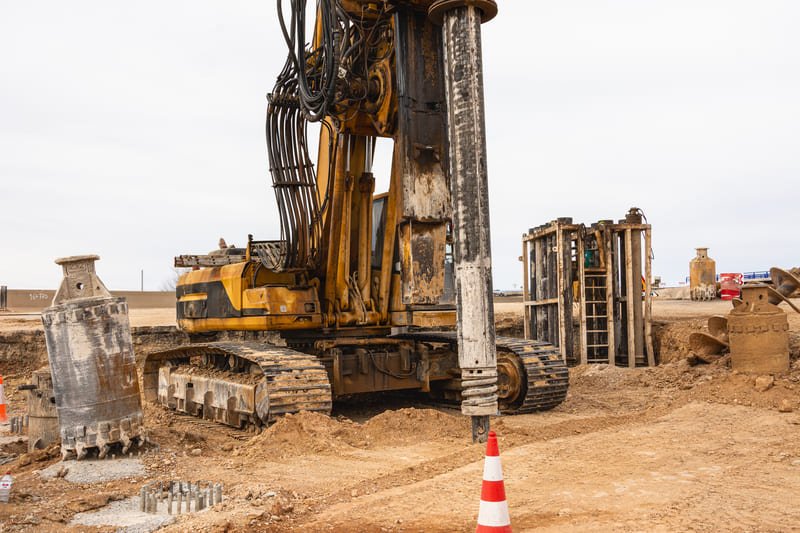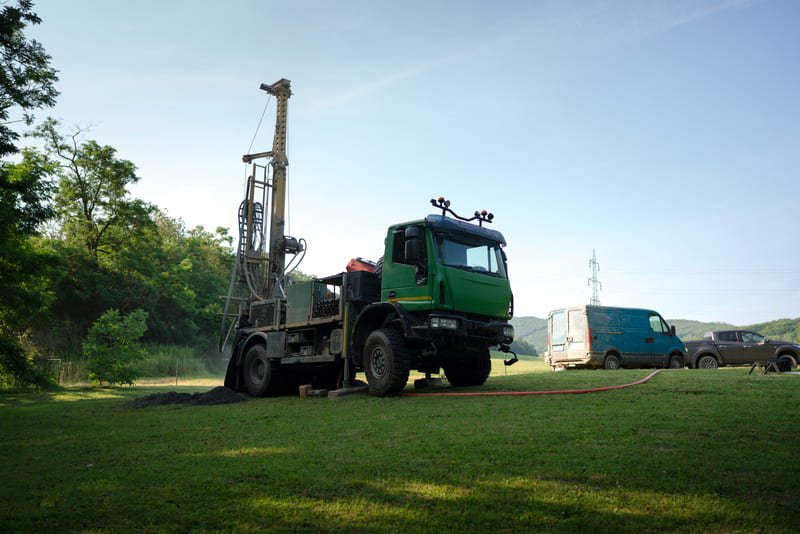Struggling with DTH drill bit balling in soft rock? You're not alone!
To prevent DTH drill bit balling in soft rock formations, it's crucial to select the right drill bit designs, use effective drilling fluid additives, and fine-tune operational parameters like rotation speed and hammer pressure.
Picture this: I'm on a drilling site, surrounded by soft, clay-rich rocks, feeling the frustration of my drill bit getting clogged with sticky debris. I remember when I first faced this issue. It was a typical Monday, and every time I thought we were making progress, the bit would stall. That's when I learned the importance of selecting the perfect bit design and tweaking our drilling fluids with the right additives. Diving into expert techniques, I discovered how adjusting rotation speeds could make all the difference. With these strategies, my drilling operations transformed from a constant battle to smooth sailing.
Soft rock formations increase DTH drill bit balling risk.True
Soft rock tends to clog drill bits, causing balling issues.
High hammer pressure reduces DTH drill bit balling.False
Excessive hammer pressure can worsen bit balling in soft rock.
What Are the Best Drill Bit Designs for Soft Rock?
Ever find yourself knee-deep in soft rock, like clay or shale, wondering why your drill bit just isn't cutting it?
The best drill bits for soft rock come with wide flushing channels, sharp cutting structures, and a concave or convex face design. These features are crucial for managing sticky formations and improving drilling efficiency.

Understanding Drill Bit Design for Soft Rock
I remember the first time I tackled a soft rock project—let's just say my drill bit and I had a rough day. If you're dealing with formations like clay or soft shale, the right drill bit can make or break your project. These materials have a knack for clinging to everything, making it essential to choose your tools wisely.
Key Features to Consider
1. Flushing Channels
Imagine trying to dig through mud with a spoon. Not fun, right? Drill bits with wide and deep flushing channels are like the shovels of the drilling world—they help clear out debris and keep your project moving smoothly.
- Example: Bits with wide flushing channels1 are lifesavers when it comes to preventing material buildup.
2. Cutting Structures
You want something sharp enough to slice through that stubborn clay. Strong cutting structures, often with carbide buttons, are what you need.
- Tip: Go for bits with sharp cutting structures2 to make your life easier.
3. Face Design
A bit with a concave or convex face can be your best friend. These designs help focus the impact and push out sticky materials.
- Consider: The perks of a convex face design3.
Importance of Drilling Fluid Optimization
Ah, drilling fluids—the unsung heroes of soft rock drilling! Choose your fluids wisely; additives can make clay less sticky and cuttings easier to handle. A well-chosen fluid can be the difference between a smooth project and one filled with headaches.
- Water-based fluids with polymers or surfactants can work wonders for cuttings removal.
Fine-Tuning Drilling Parameters
Remember, slow and steady wins the race. Lower RPMs help minimize heat and reduce that infamous clay stickiness.
- Best Practice: Keep a balanced feed rate4 to keep your bit happy and efficient.
Regular Maintenance and Operator Training
I can't stress enough how much regular maintenance saves you from unexpected downtime. Train operators to spot bit balling early so they can make adjustments before it's too late.
- Use high-pressure jets5 for efficient cleaning during maintenance.
By focusing on these elements, you'll not only make your drilling more efficient but also extend the life of your equipment—trust me, your future self will thank you.
Drill bits with wide flushing channels prevent bit balling.True
Wide flushing channels help remove debris, reducing the risk of bit balling.
Convex face design on drill bits is ineffective for soft rock.False
Convex face design helps expel sticky material, preventing buildup.
How Do Flushing Channels Reduce Bit Balling?
Ever wondered how a small design tweak could revolutionize your drilling experience?
Flushing channels combat bit balling by efficiently clearing cuttings and sticky materials from the drill bit, preventing build-up and ensuring smooth drilling operations.

The Mechanics of Flushing Channels
When I first learned about flushing channels, it was like a light bulb moment. Imagine having a drill bit that feels almost self-cleaning because of these clever grooves. These channels are not just there for show; they’re designed to let drilling fluids rush through at breakneck speeds. This action sweeps away cuttings and debris, keeping the bit face spotless and free from the sticky mess that leads to bit balling.
Flushing channels are essential6 in ensuring that cuttings and debris are constantly removed from the bit face. By doing so, they prevent the sticky buildup that characterizes bit balling.
Fluid Dynamics and Material Removal
The magic really happens with the fluid dynamics at play. I recall the first time I witnessed the jetting action in a demo—it was mesmerizing. These channels don't just loosen material; they ensure it's whisked away efficiently, like watching a tiny cleaning crew at work. The precise direction of the fluids makes sure everything is cleared out, leaving the bit ready to tackle the next challenge.
The effectiveness of flushing channels lies in their ability to direct drilling fluids precisely where needed. As the fluids move through these channels, they create a powerful jetting action that dislodges any adhering materials. The fluid dynamics7 involved ensure that the material is not only loosened but also carried away from the bit face efficiently.
| Parameter | Impact on Flushing Efficiency |
|---|---|
| Channel Width | Wider channels allow greater fluid volume and more effective debris removal. |
| Fluid Velocity | Higher velocities improve material clearance, reducing bit balling risks. |
| Channel Depth | Deeper channels support sustained fluid flow, maintaining consistent cleaning action. |
Integration with Drill Bit Design
Flushing channels aren't standalone heroes; they work best when integrated with other features of the drill bit. It's like having a team that's perfectly in sync.
Flushing channels are often integrated with other drill bit features to maximize their effectiveness. For instance, bits designed for soft formations may have additional features like convex faces that complement the function of flushing channels by focusing impact and further preventing material buildup.
- Channel Geometry: Tailoring or optimizing the shape of these channels to fit unique drilling conditions can make all the difference, providing customized solutions for varying geological conditions.
- Material Selection: Choosing tough or durable materials for the channel edges ensures they last longer, offering consistent performance over extended drilling periods.
Considerations for Optimal Performance
Getting the most out of flushing channels means considering several factors:
the type of drilling fluid used, how fast you're spinning that drill (rotational speed), and
the pressure applied during drilling (pressure you're applying). Each element can significantly influence how well these channels perform their role.
By tweaking fluid compositions or adjusting flow rates—additional strategies8—you can push
the effectiveness of these channels even further, turning a challenging job into a smoother operation.
Flushing channels reduce bit balling by 50%.False
The percentage reduction in bit balling is not specified in the context.
Wider channels allow greater fluid volume.True
Wider channels increase fluid volume, improving debris removal.
How Do Drilling Fluids Prevent Bit Balling?
Ever wondered how a gooey mess can derail a drilling operation? Enter drilling fluids, the unsung heroes that keep the show running smoothly by preventing bit balling.
Drilling fluids play a pivotal role in preventing bit balling by changing the clay's characteristics, making it less sticky and enhancing cuttings removal. This is achieved with additives like polymers, surfactants, and salts that boost fluid performance.

Understanding Bit Balling
I remember the first time I learned about bit balling—it was during a site visit when the foreman pointed out how sticky clay clung to the drill bit, slowing everything down. It was an "aha" moment for me, realizing how something so small could cause such big headaches. Bit balling occurs when materials like clay adhere to the drill bit, causing inefficiency and significant delays in drilling operations.
The Importance of Drilling Fluids
Think of drilling fluids as the lube job your car desperately needs to run smoothly. These fluids are essential in keeping the drill bit from getting bogged down by sticky stuff. They work by modifying how the bit interacts with the ground, ensuring everything flows smoothly.
Types of Drilling Fluids
Over the years, I've seen the magic of different types of drilling fluids:
- Water-Based Fluids: These are like the Swiss Army knife of drilling—versatile and cost-effective, though sometimes they struggle with tougher materials.
- Oil-Based Fluids: These are the heavy hitters, perfect for challenging formations but often come with a heftier price tag and environmental considerations.
| Fluid Type | Advantages | Disadvantages |
|---|---|---|
| Water-Based | Versatile and cost-effective | Sometimes struggle with tougher materials |
| Oil-Based | Effective in challenging formations | Higher cost and environmental concerns |
Key Additives
It’s fascinating how a sprinkle of this or that can transform drilling fluids:
- Polymers: They’re like the stabilizers in your favorite pudding recipe—keeping everything smooth and consistent.
- Surfactants: These reduce surface tension, making it easier for fluids to penetrate and whisk away debris.
- Salts: They stabilize the clay structure, cutting down on stickiness and keeping operations moving.
Optimizing Fluid Properties
Adjusting drilling fluid composition is like tailoring a suit—it needs to fit perfectly to function best. Here’s what I've learned:
- Use high-volume flushing techniques to keep the bit face clean and clear.
- Tailor fluid viscosity for specific conditions, ensuring optimal cuttings transport and minimizing downtimes.
Practical Applications
Operators need to stay on their toes, monitoring fluid properties in real-time to ensure they're fighting off bit balling effectively. It's all about being proactive—making fluid adjustments based on feedback from the ground.
Additionally, selecting appropriate drill bit designs9 and wide flushing channels10 can work hand-in-hand with these fluids. Training operators to spot early signs of bit balling is crucial; this proactive stance can dramatically boost overall efficiency. From my experience, having a team that’s alert and adaptive can save countless hours and resources.
Drilling fluids prevent bit balling by reducing clay stickiness.True
Fluids modify interactions between the bit and formation, reducing adhesion.
Oil-based fluids are less effective than water-based in all conditions.False
Oil-based fluids perform better in challenging formations, despite higher costs.
Why Is Adjusting Drilling Parameters Important?
Ever had a day when everything just clicked perfectly? That's what adjusting drilling parameters does for your operations—it's like finding that sweet spot for efficiency and safety.
Adjusting drilling parameters is essential for optimizing efficiency and preventing equipment damage. By fine-tuning elements like rotation speed and pressure, operators can adapt to geological conditions, ensuring effective drilling and reducing downtime.

Understanding Drilling Parameters
Think of drilling parameters as the dials on a radio. Just like I tweak the station to hear my favorite song clearly, adjusting these settings—like rotation speed11, pressure, and fluid flow—tunes the drill to the geological "frequency" we’re dealing with. Each geological formation demands its own melody, and without the right adjustments, it's like listening to static.
I remember this one time in a soft, clay-rich area where the rotation speed was too high. The bit kept overheating, sticking like peanut butter to a knife. Slowing down the RPMs not only cooled things down but also stopped the sticky material from accumulating on the bit. Lesson learned: sometimes slower is better!
Impact on Drilling Efficiency
Picture this: you're on a long drive, and your car’s alignment is off. The wear and tear on those tires—and your patience—mounts quickly. Similarly, misaligned drilling parameters wear out equipment and waste precious time. I’ve seen how simple tweaks can transform a frustrating day into a smooth operation.
| Parameter | Impact on Efficiency |
|---|---|
| Rotation Speed | Affects bit wear and penetration rates |
| Pressure | Influences cutting removal efficiency |
| Fluid Flow Rate | Ensures debris removal and cooling |
Equipment Longevity
Keeping equipment in top shape feels like taking care of an old friend. When I maintain an optimal feed rate12, it’s like letting my drill bit cruise at a comfortable pace, avoiding unnecessary stress. This attention to detail means fewer replacements and less downtime—what a relief!
Operators should be trained to recognize signs of parameter-related issues early. This proactive approach minimizes wear and tear, reducing the need for frequent maintenance or replacements.
Adapting to Geological Conditions
Every formation is a new adventure. Some are tough nuts to crack, requiring increased hammer pressure, while others are like soft sandcastles needing gentle handling to avoid "balling" around the drill bit. I’ve learned that using suitable drilling fluids13 with additives helps manage these challenges effectively.
By embracing these dynamics and making precise adjustments, I've seen firsthand how performance can soar across various drilling environments.
Adjusting rotation speed affects bit wear.True
Proper rotation speed reduces heat and wear, enhancing bit lifespan.
Higher fluid flow rate decreases debris removal.False
Increasing fluid flow rate improves debris removal and cooling efficiency.
How Does Operator Training Impact Drilling Efficiency?
Imagine being in the middle of a crucial drilling operation and realizing you're hitting a snag because your team isn't fully prepared. That's where operator training makes all the difference.
Operator training boosts drilling efficiency by sharpening equipment handling skills, enabling adaptation to geological challenges, and reducing disruptions. This leads to smoother operations and less downtime.

Understanding the Role of Operator Training
I remember my first drilling project like it was yesterday—nervous yet excited, standing next to seasoned operators. Watching them skillfully manage the equipment, I realized that their training was the backbone of our operation. Operator training is crucial for optimizing drilling efficiency14. Skilled operators can adapt their techniques to varying geological conditions swiftly, which is vital in preventing issues like bit balling.
Key Areas of Training Impact
-
Equipment Management: I’ve seen firsthand how comprehensive training on managing various drilling equipment types, such as DTH (Down-The-Hole) and top hammer systems, empowers operators. Knowing the nuances of each system allows them to make real-time adjustments that maintain efficiency.
-
Geological Adaptation: Well-trained operators can identify and adapt to diverse geological conditions, reducing equipment wear and tear. This adaptability minimizes chances of operational halts due to unforeseen circumstances.
| Training Aspect | Impact on Efficiency |
|---|---|
| Equipment Handling | Optimizes performance and reduces wear |
| Geological Adaptation | Enhances flexibility in variable conditions |
| Preventive Maintenance | Minimizes downtime through proactive measures |
Case Study: Impact on Bit Balling Prevention
I recall a situation where a trained operator recognized early signs of bit balling. He adjusted rotation speeds and used suitable drilling fluids, ensuring continuity in operations and mitigating downtime. This proactive approach was a game-changer for our team.
Integrating Technology with Training
In recent years, I’ve noticed how technology has transformed our training programs. Modern setups incorporate tools like simulators15 and VR (Virtual Reality) to provide immersive learning experiences. These tools allow operators to practice in a risk-free environment, honing their skills before working on-site.
Benefits of Technological Integration
- Simulators: Offer realistic scenarios that train operators to handle complex situations efficiently.
- Virtual Reality: Provides a hands-on experience in a controlled setting, enhancing learning outcomes.
By leveraging these technologies, operators can refine their techniques, leading to heightened efficiency and reduced error rates during actual drilling operations.
Continuous Learning and Efficiency Metrics
Continuous learning is something I strongly advocate for sustaining high levels of efficiency. Regular workshops and updates on the latest drilling technologies16 ensure that operators stay ahead of industry advancements.
Metrics for Measuring Training Impact
- Operational Downtime: Track reductions in downtime attributable to improved operator skills.
- Equipment Longevity: Evaluate how enhanced handling extends equipment life.
- Productivity Rates: Measure increases in output post-training sessions.
By establishing robust metrics, companies can assess the direct impact of training programs on overall operational efficiency. This data-driven approach supports continuous improvement and informed decision-making regarding future training investments.
Operator training reduces drilling downtime.True
Training equips operators to handle issues proactively, minimizing downtime.
Simulators are not used in modern operator training.False
Simulators provide realistic scenarios for operators to practice efficiently.
What Maintenance Techniques Help Prevent Bit Balling?
Ever found yourself knee-deep in a drilling operation, only to be halted by the dreaded bit balling?
Prevent bit balling by choosing the right drill bit, optimizing drilling fluids, and maintaining regular cleaning routines. These steps keep your drilling operations smooth and efficient, minimizing downtime caused by sticky material buildup.

Selecting the Right Drill Bit Design
I remember the first time I encountered bit balling—what a nightmare! Imagine standing there, helpless as the clay clung to the bit, bringing everything to a grinding halt. Choosing the right drill bit can make all the difference. Bits designed for soft or clay-rich formations17 often come with concave or convex faces, which help expel sticky materials right from the center.
| Drill Bit Features | Benefits |
|---|---|
| Concave/Convex Faces | Expels sticky materials effectively |
| Wide Flushing Channels | Efficiently removes cuttings and debris |
Optimizing Drilling Fluids
Effective drilling fluid management was another game-changer for me. By using water-based fluids with special additives like polymers or surfactants, I found that I could drastically reduce the stickiness of the clay. High-volume flushing ensures that the bit face remains clean, continuously removing any sticky materials before they become a problem.
- Fluid Additives: Enhance cuttings removal and reduce stickiness
- High-Volume Flushing: Ensures continuous cleaning of the bit
Adjusting Drilling Parameters
Fine-tuning drilling parameters is not just a technical adjustment—it's a strategic move. By controlling rotation speed and hammer pressure, I've managed to minimize heat generation, which usually increases clay stickiness. Balancing the feed rate was crucial too; it allowed for optimal cutting removal without stressing the bit.
- Rotation Speed: Lower RPMs for reduced heat
- Feed Rate: Optimize for maximum cutting removal
Regular Maintenance and Cleaning
Routine inspections and cleaning became my best practices. I can't stress enough how important it is to regularly pull out and inspect bits to prevent material buildup. Using high-pressure air or water jets ensures thorough cleaning, making sure all channels are clear and ready for action.
- Routine Inspections: Pull out and inspect bits regularly
- Cleaning Techniques: High-pressure jets for thorough cleaning
Operator Training and Adaptation
I've seen firsthand how vital it is to train operators on these challenges. Well-trained operators can spot early signs of bit balling and make swift adjustments. Encouraging adaptive practices based on real-time feedback has been essential for me.
- Operator Training: Essential for recognizing early signs
- Adaptive Practices: Tailor techniques to immediate drilling feedback
If you're curious about diving deeper into this topic, explore related subjects like drilling fluid additives18 and bit design innovations19.
Wide flushing channels reduce bit balling.True
Wide channels efficiently remove cuttings, preventing accumulation.
High RPMs reduce clay stickiness during drilling.False
High RPMs increase heat, making clay stickier and causing balling.
Conclusion
Prevent DTH drill bit balling in soft rock by selecting appropriate bits, optimizing drilling fluids, adjusting parameters, and ensuring operator training for efficient operations and reduced downtime.
-
Learn how wide flushing channels improve cuttings removal and prevent bit balling. ↩
-
Discover why sharp cutting structures enhance drilling performance in sticky formations. ↩
-
Explore how convex face designs help manage sticky materials during drilling. ↩
-
Understand how a balanced feed rate optimizes cutting removal and protects the drill bit. ↩
-
Find out how high-pressure jets are used to clean drill bits effectively. ↩
-
This link explains why flushing channels are crucial in preventing bit balling and maintaining drilling efficiency. ↩
-
Learn about how fluid dynamics play a role in enhancing the effectiveness of flushing channels. ↩
-
Explore additional methods to complement flushing channels in preventing bit balling during drilling. ↩
-
Discover how specific drill bit designs help reduce bit balling through advanced engineering solutions. ↩
-
Learn about the benefits of wide flushing channels for efficient cuttings removal and reduced bit balling. ↩
-
Discover guidelines for setting rotation speed in clay-rich formations to improve efficiency and reduce equipment wear. ↩
-
Learn how adjusting feed rates can prolong drill bit lifespan by avoiding excessive stress. ↩
-
Explore additives that improve fluid efficiency in soft rock formations, enhancing cuttings removal. ↩
-
Explore how operator training directly enhances equipment handling, adaptability, and operational efficiency. ↩
-
Learn about how simulators provide realistic practice environments for drilling operators. ↩
-
Discover new technologies that are transforming efficiency and productivity in drilling operations. ↩
-
Explore which drill bits are most effective in clay-rich conditions to enhance your understanding of suitable designs. ↩
-
Discover how specific drilling fluid additives work to reduce stickiness in clay-rich environments. ↩
-
Stay updated on cutting-edge designs that improve performance in challenging formations. ↩








